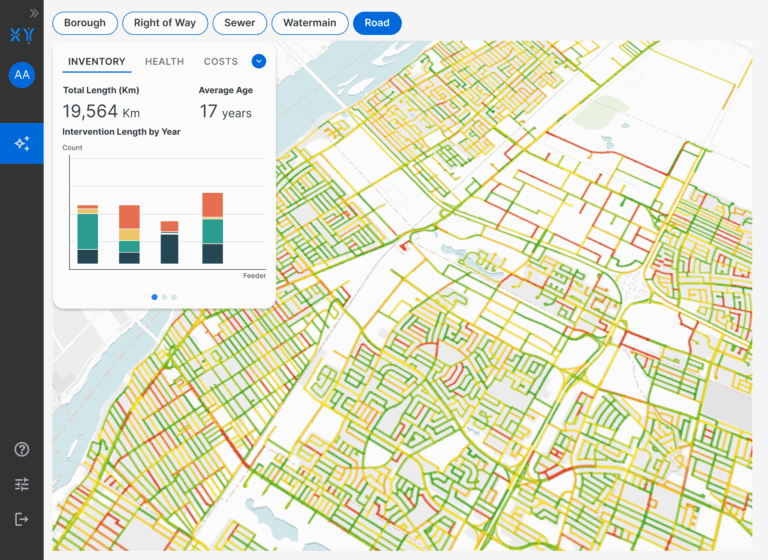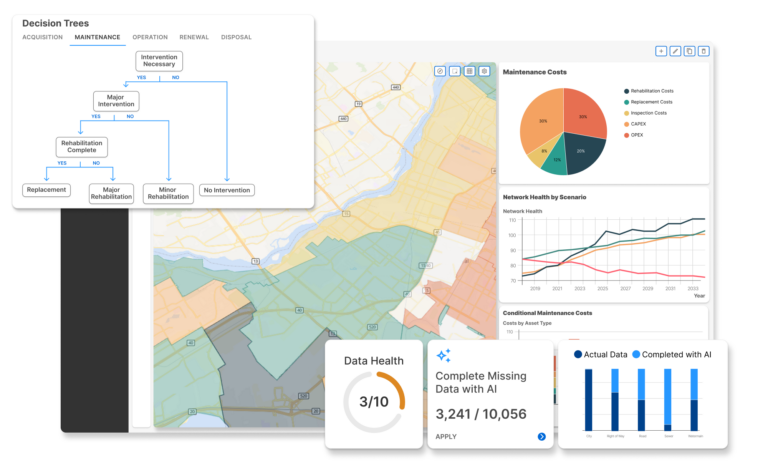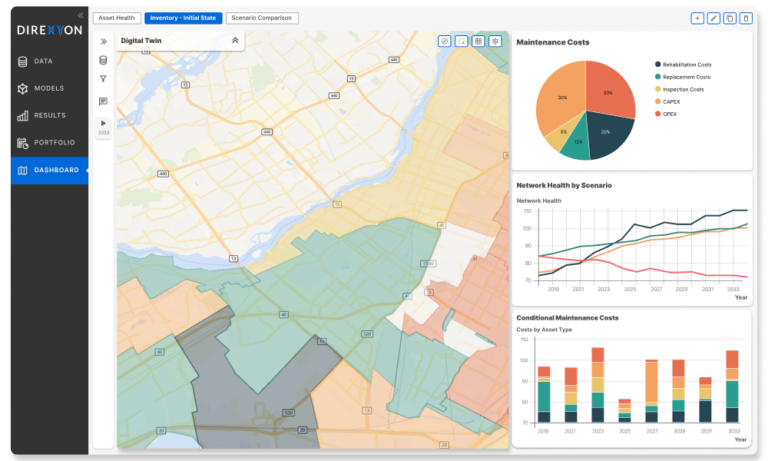How can municipalities achieve and sustain levels of service?
Canadian municipalities are responsible for 60% of our public infrastructure. Ensuring our roads are safe and our water is reliable depends on identifying and maintaining satisfactory levels of service.
Maintaining the levels of service of complex road and water networks comes not only at a cost, but a series of difficult decisions. Finding and sustaining levels of service for public infrastructure assets, especially in the age of climate change, requires visibility on all the municipality’s assets and their impact on budget, impact, etc. to make timely decisions.
Understanding municipal levels of service frameworks
According to the Federation of Canadian Municipalities and National Research Council, municipal levels of service are “a composite indicator that reflects the social and economic goals of the community.”
These goals can include: safety, customer satisfaction, capacity, reliability, environmental acceptability, cost, or many more.
Municipalities are free to choose which, if any, of these goals are priority, so long as they can be tracked by data.
Ultimately, levels of service are a way to track data over time and assess how well municipalities are achieving their goals despite budgetary constraints. Rather than rely on instinct or experience to judge where they are, the number of service outages, boil water advisories, road closures, or citizen complaints can clearly demonstrate a strategy’s performance.
In their simplest form, municipal levels of service frameworks are finding the balance between cost, performance, and risk.
For example, a city could replace its water infrastructure to mitigate breakage rates and leaks. But doing so is expensive. The city would have to significantly raise property taxes to fund all the replacements. If only a fraction of the replacements can be done, where can the city invest to reduce risk and improve performance with the budget available?
Higher performance and less risk comes at a cost. Under-investing can increase risk and decrease performance.
With a levels of service framework in place, the tradeoffs between cost, risk, and performance become much clearer.
Benefits of implementing levels of service frameworks
Implementing a levels of service framework provides several benefits for Canadian municipalities. Firstly, it allows for a clear understanding of the expectations and needs of the community. By defining specific service levels, municipalities can ensure they meet the demands of their residents.
Additionally, levels of service frameworks help in prioritizing resources and budget allocation. By identifying critical services and setting appropriate performance targets, municipalities can allocate their resources effectively and efficiently.
Furthermore, implementing levels of service frameworks improves accountability and transparency. By establishing measurable performance targets, municipalities can track their progress and report to the public, ensuring transparency in service delivery.
Lastly, levels of service frameworks enable municipalities to identify areas for improvement and optimize service delivery. By regularly assessing and evaluating service performance, municipalities can identify gaps or inefficiencies and take necessary actions to enhance overall service quality.
Challenges in Canadian municipalities
The major challenge Canadian municipalities face when it comes to achieving sustainable levels of service are resources.
From big cities to rural township, every Canadian municipality struggles with limited budgets. As a result, maintaining and improving infrastructure assets is always in competition against other priorities. Financial constraints often force municipalities to make less than optimal tradeoffs regarding performance and risk to save on cost.
And this is particularly troublesome given that a significant portion of municipal public infrastructure is reaching its end of life in conjunction with climate change and population growth. Climate change brings more frequent and severe weather events, which accelerate the degradation of assets. Additionally, changing demographics put pressure on existing infrastructure and assets that weren’t designed to support a certain level of use when they were built in the 1950s and 1960s. Even infrastructure built in the 1980s and 90s may not be able to withstand new usage.
Even with levels of service frameworks in place, the right path forward is seldom clear.

Sustainable service delivery with Asset Investment Planning
Levels of service frameworks are an essential way to measure to track asset performance within a municipality. However, they are ultimately a reactive metric.
Levels of service provide a snapshot of current performance and are useful for evaluating areas that need improvement. But when relying solely on levels of service frameworks to assess new improvements, the only way to know if our predictions are off is to wait and see if we made the right decision.
Unless you’re using an Asset Investment Planning solution like Direxyon.
Asset Investment Planning (AIP) enables municipalities to virtually simulate and discern the best course of action regarding your municipal infrastructure. It does this by:
Creating an inventory of all assets. Using data from any source, format, or vendor, municipalities get a holistic view of all their infrastructure assets in their portfolio.
Defining your levels of service. Using a municipality’s expertise and values, decision trees are built to ensure that levels of service are incorporated into simulation results.
Simulating possibilities. With the data and decision trees collected into an AIP, municipalities can simulate long-term to see the impact of their current strategy on the tradeoffs between cost, performance, and risk.
Testing what-if scenarios. If the simulation reveals the current strategy is going to be prohibitively expensive, risky, or can’t sustain the desired performance of assets, municipalities can try something different.
For example, they may want to test prioritizing rehabilitations over replacements. Or how much they might save by synchronizing water main maintenance with road reconstructions. Or what happens to their performance projections by investing in their riskiest assets.
Regardless of specific priorities, municipalities can leverage Asset Investment Planning solutions to make levels of service a predictive metric that supports sustainable infrastructure, improves service delivery, and enhances the overall quality of life for residents.
Achieving your levels of service
Asset Investment Planning offers municipalities a forward-thinking approach to managing their assets and infrastructure.
Municipalities looking to enhance their service delivery and ensure sustainable infrastructure must consider integrating AIP solutions like Direxyon. Take a step towards sustainability in your municipality and tell us about your level of service objectives.
Direxyon Municipal Asset Management Solutions
How Direxyon’s Asset Investment Planning solution helps Canadian municipalities.

Map all your assets
Import all your asset data from any source, format, or vendor and visualize them on a map, by neighbourhood, by projects, costs, etc.

Compare your strategies
Simulate and compare asset intervention strategies to see their long-term viability based on cost, risk, performance, etc.

Create your investment plan
Select priority initiatives and plan your investments accordingly. Allocate resources to your entire municipal infrastructure portfolio: water, roads, buildings, transportation, etc.
Need help producing your Municipal Asset Management plans?
Contact us today and tell us about your municipality’s goals.
Asset Investment Planning FAQs
Asset Investment Planning (AIP) software enhances the long-term, strategic thinking of asset-intensive organizations to optimize performance and minimize risk. By consolidating asset, financial, and regulatory data in a single solution, alongside organization-specific decision-making policies and predictive models, organizations can simulate possible futures and test investment scenarios to make informed decisions aligned with their strategic goals. Learn more about our AIP software.
Traditional asset management often focuses on day-to-day operations and reactive maintenance, relying on historical data and experience rather than predictive analytics and strategic planning. It typically does not prioritize immediate needs over long-term planning and may not integrate financial considerations or advanced risk management strategies as comprehensively as Asset Investment Planning.
Asset Investment Planning is not a standalone process but rather integrative across an organization. It provides a holistic approach to managing assets, factoring in risk, finance, regulatory requirements, operations, and more. In integrating all these aspects of a single organization, silos are replaced by strategic alignment.
The first step to adopting an AIP is to book a demo with Direxyon.






